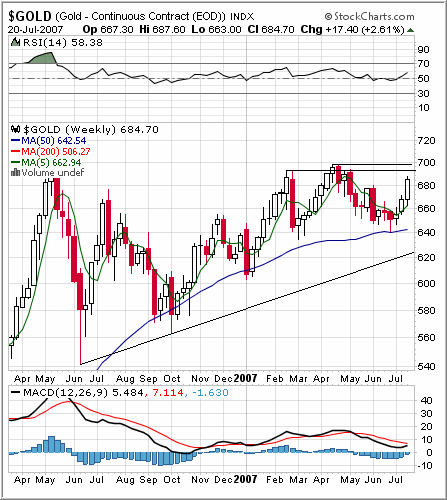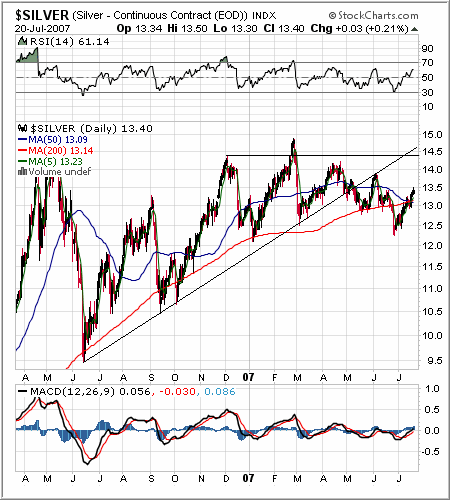Gold and Silver Analysis - Precious Points: Good As Gold
Commodities / Gold & Silver Jul 22, 2007 - 06:07 PM GMTBy: Joe_Nicholson
 “There is strong overhead resistance in gold, first at $680 and again just below $700, but over the past year every consecutive weekly close above the 5-week moving average has signaled a move to a new high… Silver resistance lies overhead near $13.40 and again just below $14. If we really start rolling, the possible target for this move is near $14.50.” ~ Precious Points: Are Metals Next?, July 14, 2007
“There is strong overhead resistance in gold, first at $680 and again just below $700, but over the past year every consecutive weekly close above the 5-week moving average has signaled a move to a new high… Silver resistance lies overhead near $13.40 and again just below $14. If we really start rolling, the possible target for this move is near $14.50.” ~ Precious Points: Are Metals Next?, July 14, 2007
After weeks of disappointing underperformance, standing on the sidelines as stock indices reached all-time highs, it was the precious metals' turn to shine again and post nice gains while other assets languished. Despite starting the week slowly, gold and silver rallied from Wednesday on, a day when the NY Fed happened to add $7.25 billion in new repo funds. Metals picked up steam with the release of higher than expected core inflation data, hawkish testimony from Bernanke, further declines in the dollar, and a flight to quality triggered by subprime concerns and earnings misses from high profile blue chip stocks.
Having called the last top in gold back in April, and then pounding the table on the 50-week moving average in late June, this update is again vindicated by the recent price action in gold and silver. The charts show gold extending its gains above the 5-week moving average right into the resistance described at $680. Silver successfully closed two consecutive weeks above the 5-day moving average and topped out for the week right at the $13.40 level described in the previous update.


But the boldest statement in any of the recent updates was the proposition that the Fed's approach to monetary policy may force it to cut rates if the subprime and credit issues reduce overall demand for base money. A steady interest rate, during a credit crunch, would tend to slow the pace of money supply expansion, exacerbating any ill effects on the economy. At the time, the statement might have seemed a bit out of place, but odds of a quarter-point hike by year end nearly doubled last week, reaching 42% after Bernanke's warning about potential spillover from subprime mortgage defaults. In addition to the technical indicator provided by the 5-week and 5-day moving averages shown above, the fundamental outlook for the intermediate term is based on this potential devaluation of the dollar if the Fed is forced by credit issues to intervene.
Readers of this update should have found it no surprise that Bernanke's testimony marketed the start of this week's metals rally. As noted previously, Bernanke's speech two weeks ago, coupled with seemingly tame core inflation data, indicated his willingness to cut rates to stimulate an economy wrestling with subprime spillover. Other updates described how Bernanke's rate-targeting regime allows money supply to expand with economic growth, creating perpetual inflation.
In his testimony before the House last week, the Fed chairman was explicitly questioned about Fed's policies and the possibility of a dollar crisis by plucky Representative, and dark horse presidential candidate, Ron Paul, whose question referenced the 1979-80 dollar devaluation. Bernanke's very evasive answer was simply that he was “confident” the Fed could prevent such a calamity, but in a world of floating currencies, all of which are being rapidly devalued by excess creation, the dollar could actually gain ground relative to other currencies while losing value as measured in gold. This, in fact, is roughly what occurred in '79-80.
As any gold trader knows, 1979-80 is the period that saw gold reach its all time high of $850/oz. More accurately, the dollar reached an all-time low of 1/850 ounce of gold. Meanwhile, currency exchange rates were roughly steady as foreign central banks engaged in “race for the bottom” devaluation parity. At the time, the Fed's policy was the exact opposite of the current rate-targeting regime; a steady rate of money supply growth was maintained, even as demand for money slackened, and interest rates were left to float, with the result of double digit inflation in early 1980.
Under Bernanke's helm, expansion of the money supply is much closer linked to demand for money, which tends to keep inflation contained compared to 1980 levels, but if the Fed is forced to inject new money to stimulate borrowing in the wake of a subprime-induced credit collapse, it's difficult to see how the absolute buying power of the dollar, measured against gold, would not suffer. The fact that subprime borrowing concerns are also beginning to appear in European countries suggests the Fed may very well have the opportunity to use relatively stable exchange rates as a cover for their money creation.
In the end, Bernanke's non-answer left ambiguous whether he was referring to a weighted currency measure of the dollar or the gold measured value, but in light of his recent presentations and past proclivities, it still seems very likely that Bernanke stands at the ready to rescue the economy with another round of dollar devaluing liquidity which, while unfortunate for the dollar-denominated assets of most, works for the benefit of precious metals investors. Faced with assurances that the Fed would mysteriously maintain the value of the dollar, “With your fingers crossed, I guess”, was Paul's all too appropriate response.
Next week is relatively light on economic data, and most of the earnings data will center on Dow components and consumer-oriented companies. Given the recent weakness in retail sales, there is a significant risk that the earnings disappointments could continue and Q2 GDP might simply add to that list. If the fear of a real credit crisis expands and continues fueling flight to quality trading and heightened rate cut expectations, this could be the catalyst for a new run at the recent highs. The decline in treasury yields should also work to make metals a more attractive investment for new buyers. After all, there's a reason for the expression “good as gold”, because even if all the fiat currencies disappear and all governments default on their loans, gold and silver will still be real money.
If, on the other hand, next week's earnings are acceptable, stocks find their footing and the next wave of corporate paper issuance is allowed to work its way through the economy, metals could resume a more sideways trading pattern, though with an upward bias as economic growth fuels expansion of the money supply and real inflation. The support and resistance levels outlined above remain critical levels to watch and trade.
by Joe Nicholson (oroborean)
This update is provided as general information and is not an investment recommendation. TTC accepts no liability whatsoever for any losses resulting from action taken based on the contents of its charts,, commentaries, or price data. Securities and commodities markets involve inherent risk and not all positions are suitable for each individual. Check with your licensed financial advisor or broker prior to taking any action.
Joe Nicholson Archive |
© 2005-2022 http://www.MarketOracle.co.uk - The Market Oracle is a FREE Daily Financial Markets Analysis & Forecasting online publication.


